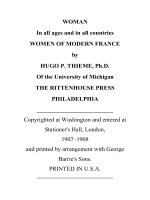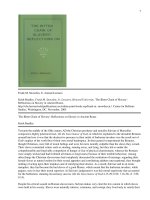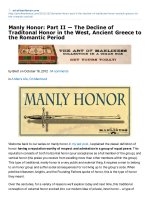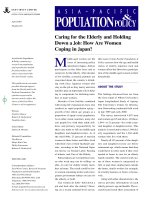Women poets in ancient greece and rome
Bạn đang xem bản rút gọn của tài liệu. Xem và tải ngay bản đầy đủ của tài liệu tại đây (1.05 MB, 257 trang )
01.Greene Front Matter 3/18/05 2:08 PM Page i
Women Poets in
Ancient Greece
and Rome
01.Greene Front Matter 3/18/05 2:08 PM Page ii
01.Greene Front Matter 3/18/05 2:09 PM Page iii
Women Poets in
Ancient Greece
and Rome
Edited by
Ellen Greene
UNIVERSITY OF OKLAHOMA PRESS : NORMAN
01.Greene Front Matter 3/18/05 2:09 PM Page iv
Also by Ellen Greene
Reading Sappho: Contemporary Approaches (Berkeley, 1996)
(ed.) Re-reading Sappho: Reception and Transmission (Berkeley, 1996)
The Erotics of Domination: Male Desire and the Mistress in Latin Love Poetry
(Baltimore, 1998)
Library of Congress Cataloging-in-Publication Data
Women poets in ancient Greece and Rome / edited by Ellen Greene.
p. cm.
Includes bibliographical references (p. ) and index.
ISBN 0–8061–3663–4 (alk. paper)—ISBN 0–8061–3664–2 (pbk. : alk.
paper)
1. Greek poetry—Women authors—History and criticism. 2. Latin
poetry—Women authors—History and criticism. 3. Women—Greece—
Intellectual life. 4. Women—Rome—Intellectual life. 5. Women and
literature—Greece. 6. Women and literature—Rome. 7. Women in
literature. I. Greene, Ellen, 1950–
PA3067.W66 2005
880'.09—dc22
2004062023
The paper in this book meets the guidelines for permanence and durability of
the Committee on Production Guidelines for Book Longevity of the Council
on Library Resources. ∞
Copyright © 2005 by the University of Oklahoma Press, Norman, Publishing
Division of the University. All rights reserved. Manufactured in the U.S.A.
1 2 3 4 5 6 7 8 9 10
01.Greene Front Matter 3/18/05 2:09 PM Page v
For my sister
DEBRA
01.Greene Front Matter 3/18/05 2:09 PM Page vi
01.Greene Front Matter 3/18/05 2:09 PM Page vii
Contents
Acknowledgments
ix
Introduction
Ellen Greene
xi
1. Sappho’s Public World
Holt Parker
3
2. Corinna’s Poetic Metis and the Epinikian Tradition
David H. J. Larmour
25
3. The Power of Memory in Erinna and Sappho
Diane J. Rayor
59
4. Dico ergo sum: Erinna’s Voice and Poetic Reality
Elizabeth Manwell
72
5. Homer’s Mother
Marilyn B. Skinner
91
6. Nossis Thêlyglôssos: The Private Text and the Public Book
Marilyn B. Skinner
112
7. Playing with Tradition: Gender and Innovation in the
Epigrams of Anyte
Ellen Greene
139
8. Sulpicia and the Art of Literary Allusion: [Tibullus] 3.13
Carol U. Merriam
158
01.Greene Front Matter 3/18/05 2:09 PM Page viii
viii
CONTENTS
9. Sulpicia and the Rhetoric of Disclosure
Barbara L. Flaschenriem
169
Appendix: Greek and Roman Women Writers
192
List of Abbreviations
197
Bibliography
199
Notes on Contributors
219
Index
223
01.Greene Front Matter 3/18/05 2:09 PM Page ix
Acknowledgments
This book was a long time coming. I first had the idea for it in
1996 while I was working on my two Sappho volumes. It was then
that I became committed to making a contribution to the small but
growing body of scholarship on Greek and women poets. I am
extremely grateful to John Drayton, Director of the University of
Oklahoma Press, for his unwavering enthusiasm and support. Jennifer
Cunningham and Julie Shilling, Associate Editors at the Press, have
been very helpful as well. I also want to thank Paul Allen Miller and
David Larmour for their belief in this project in its early stages. Professor Miller’s insights and unfailingly perceptive readings helped to
make this a better book. I owe a deep dept to Marilyn Skinner, whose
pioneering work on women poets in Ancient Greece has inspired
much of my own interest in the poets represented in this volume.
I could not have completed the work for this project without
the help of the University of Oklahoma. The Department of Classics
and Letters, the College of Arts and Sciences, and the Office of
Research Administration provided invaluable moral and financial
support. In particular, I am grateful to my department chair, John
S. Catlin, for always supporting my professional endeavors.
On a more personal note, I am deeply appreciative of the constancy, affection, and lively companionship of my partner, Jim. This
book is dedicated to Debra—my sister, best friend, and the mother
of my beloved nephew, Justin.
01.Greene Front Matter 3/18/05 2:09 PM Page x
01.Greene Front Matter 3/18/05 2:09 PM Page xi
Introduction
Ellen Greene
The interpretation of women’s literature in Greek and Roman antiquity is a notoriously challenging enterprise. To be sure, the relative
obscurity of historical knowledge surrounding Greco-Roman texts in
general invites a higher degree of speculation than modern literary
texts generally do. Yet the texts of women authors in ancient Greece
and Rome present especially difficult challenges. Most obvious, the
fragmentary condition of much of extant women’s writing in GrecoRoman antiquity makes it particularly susceptible to ambiguity. More
important, women’s status in antiquity—the constraints on their
legal and political rights, their limited educations, and the extreme
restrictions placed on their involvement in the public sphere—renders
knowledge about the conditions attendant on women’s literary productions especially obscure. In addition, much of what we “know” of
ancient women has come down to us through the images created of
them in male-authored texts. While women’s own writing might
seem to make the possibilities of ancient female subjectivity accessible
to us, we cannot be certain about the effects of male constraints on
female agency within the performative contexts of women’s poetry in
the male-dominated societies of Greece and Rome. Indeed, classical
scholars over the years have often lamented the extreme paucity of
extant women’s writing.1 On the other hand, we have to wonder how
women in Greece and Rome wrote and performed their poems at all,
01.Greene Front Matter 3/18/05 2:09 PM Page xii
xii
INTRODUCTION
considering their apparent marginality within the cultures in which
they lived and wrote.
While the women poets of Greece and Rome have at times fascinated modern scholars, much of the scholarship until recently has
been either mildly dismissive or openly denigrating. Early twentiethcentury scholars often focused on women’s biographies, assuming
that there was little poetic artistry to unearth and that women
would naturally be concerned exclusively with the “trivialities” of
their private lives.2 Even scholars who wrote admiringly of Sappho’s
poems, for example, emphasized aspects of her work they perceived
to be expressive of purely personal emotions.3 On the less positive
end of this continuum we find scholars such as Devereux and
Marcovich, who characterized the seemingly “confessional” quality
in Sappho’s poems as hysterical and neurotic.4 Overall, the emphasis
on women’s biographies and on the seemingly “personal” nature of
their literary achievements has occluded the highly intricate and
complex character of ancient women’s relationships not only to
their largely patriarchal societies but also to literary traditions overwhelmingly dominated by male voices.
While it is certainly true that for the most part Greek and Roman
women occupied marginal positions in society, there is much evidence to suggest that in certain periods women had at least some
exposure to male literary culture. Even in archaic and early classical
Greece, where adult women were segregated from the larger public
sphere except on ritual occasions, there are indications that women
might have produced their own discourses in isolation. The world
Sappho inhabited, for example, as represented in her poems seems to
be comprised of a community of women within a socially segregated
society—a society that appears detached from male “public” arenas.5
Overall, in spite of the formal exclusion of women from the public
domain in both Greek and Roman culture, women poets clearly
had some familiarity with literary culture as well as with traditionally
masculine forms of public and political expression. The references
in Greek and Roman (male) texts to women as practitioners of literature strongly suggest that a tradition of female authorship flourished
from the Archaic Age (ca. 700 bce) into the Hellenistic and Roman
periods. A canonical roster of women poets was first compiled by
the learned scholars of Alexandria and was in circulation by the time
of Augustus in imperial Rome. Sappho was not only the earliest but
by all accounts the most highly regarded woman poet in Greek and
Roman antiquity. Both classical and Hellenistic women writers looked
01.Greene Front Matter 3/18/05 2:09 PM Page xiii
INTRODUCTION
xiii
back to Sappho as their exemplar. While Sappho’s work has received
considerable scholarly attention in recent years (as have the representations of women in male-authored texts), there are currently no published collections that examine a women’s poetic tradition in Greece
and Rome or even focus exclusively on women’s own voices in Greek
and Roman literature.6 The nine essays collected here treat nearly all of
the surviving poetry written by Greek and Roman women.
During the last two decades feminist approaches in classical
scholarship have examined the extent to which Sappho’s poems and
those of her literary successors present a woman-specific discourse
that secures a female perspective within male-dominated discursive
systems. While the relationship between public and private spheres
in the lives of ancient women is a complex one, it is clear that the
female voice in ancient lyric reflects the marginal status of women in
Greek and Roman societies (see Cantarella 1987). One of the unifying themes of this collection is the investigation of the intricate
relationship between “public” and “private” discourses in the poetry
of ancient Greek and Roman women. Many of the authors in this
volume interrogate the bilingual nature of women’s poetic discourses,
that is, the ability of women poets to speak in the languages of both
the male public arena and the excluded female minority.7 Perhaps
the most pressing concern for scholars working on women’s poetic
texts is how to situate women poets within a dominant male literary
tradition. A central issue in the majority of the essays here concerns
questions about the extent to which women’s poetry in Greece and
Rome may be characterized as distinctly “feminine” or at least as
“woman-identified,” to use Diane Rayor’s term (1993). Some of
the essays in this collection also raise questions about the relationship between female-authored poetry and traditional female speech
genres. Other essays focus more on how female poets deviate from
their male counterparts.
More generally, the collection as a whole addresses the relationship between gender and genre, sexuality and textuality, and implicitly
raises the question as to whether Greek and Roman women may be
said to have a poetic tradition of their own—despite the fragmentary
nature of their surviving poetic texts. Although I do not think it
possible to answer that question definitively given our limited knowledge, I do think the essays here point to a surprising degree of congruity and complementarity among female authors writing during
vastly different periods. To be more specific, the women poets treated
in this collection represent a body of work that shows an extraordinary
01.Greene Front Matter 3/18/05 2:09 PM Page xiv
xiv
INTRODUCTION
awareness of literary tradition while at the same time often revealing
concerns that may be described as distinctly feminine. Moreover,
many of the essays in this volume show how women poets in Greece
and Rome, through their innovative reworkings of myth and appropriations of male literary forms, did not merely imitate the prevailing
patriarchy (as some scholars have maintained) but uncovered their
own art forms within established literary genres. Although the precise dates for many of the authors treated in the collection are either
controversial or uncertain, the essays have been arranged in a loose
chronological fashion. While this arrangement by no means assumes
a continuous line of historical development, it will nonetheless help
to clarify influences where they might exist.
In the opening essay of the collection, “Sappho’s Public World,”
Holt Parker argues against the view common in recent scholarship
that Sappho’s poetry is concerned exclusively with private matters
such as weddings and love affairs. Parker cautions, rightly, about the
dangers of projecting onto Sappho notions about an “essentialized”
image of woman. While he acknowledges that what remains of
Sappho’s poetry is primarily concerned with traditionally “feminine” concerns, he argues that Sappho’s references and allusions to
public and political life ought to be taken into account within the
context of her body of work. Parker points out that Sappho’s concern
with defining the noble man, and with ethics in general, reflects the
degree to which the public world of aristocratic values and friendship is an important component of her poetry.
Like many of the authors in this volume, Parker has clearly benefited from critical approaches that tend to privilege the feminine in
the texts of Greek and Roman women poets. His essay, however,
reflects recent trends in scholarship that emphasize the interplay in
those texts between the public and the private, the traditional and
the innovative. David Larmour’s essay on Corinna, “Corinna’s Poetic
Metis and the Epinikian Tradition,” also addresses the issue of how
Greek women poets appropriate and ultimately transform aspects of
male literary form and conventions. His essay explores how Corinna’s
mythological narratives refashion male traditions of choral lyric—
and diverge from or even react against the poetic mode of Pindar’s
Panhellenic epinikians—as Corinna reworks a Panhellenic perspective, subsuming it within the local raw material of her poems. Yet
Larmour argues that Corinna’s use of irony and incongruity in her
treatment of mythological narrative serves to challenge, albeit subtly,
the conventions of the epinikian mode. Examining Corinna’s two
01.Greene Front Matter 3/18/05 2:09 PM Page xv
INTRODUCTION
xv
main fragments—the singing contest of Cithaeron, and Acraephen’s
reply to Asopus about his daughters—Larmour shows how Corinna’s
inventive reworking of these narratives foregrounds female figures
and experiences, suggesting that her poems were composed primarily
for female audiences. By analyzing the two fragments as a single
unit of signification, he draws together their shared motifs of
secrecy and disclosure. In addition, he evaluates the tradition of the
rivalry between Corinna and Pindar within the broader agonistic
context of athletic competition and epinikian poetry. While Larmour
acknowledges that Corinna works within a patriarchal tradition, he
concludes that her “woman-identified” perspective subjects elements
of that tradition to scrutiny.
The longest portion of this collection treats the Hellenistic
women poets, whose work represents the largest and most diverse
surviving body of women’s poetry from Greek and Roman antiquity.
During the Hellenistic period women were offered new opportunities for education, women poets were revered as never before, and
were rewarded for their talents with prizes, state decrees, and even
political rights. Some scholars have argued, however, that as Hellenistic women gained greater literacy, women poets produced poems
for a predominantly male audience, trading the woman-specific
poetic discourse of earlier eras for an aping of patriarchal values and
modes of speech. In various ways, however, the authors of essays in
this collection on Anyte, Erinna, Moero, and Nossis challenge this
position. While the focus on women’s lives and community and the
resonances of Sappho as a literary exemplar may identify the poetic
voices of Hellenistic women poets as peculiarly feminine, the interaction between their woman-identified art and the established male
literary culture and convention often results in highly innovative
forms of poetic discourse.
Diane Rayor’s essay focuses on the power of memory in Erinna’s
poetry. While Rayor situates Erinna’s epigrams within the Sapphic
tradition, she points out how the changes in the performative context from the seventh to the fourth centuries bce suggest that
Erinna’s epigrams cannot, like Sappho’s poetry, encompass a communal audience of women with a shared memory. Rayor shows,
however, how the memory of a beloved woman in both Sappho
and Erinna functions as a vehicle of poetic inspiration and creation.
As Rayor demonstrates, Sappho recalls the beloved woman in part
to provoke ongoing communication within a living community of
women. Sappho’s songs therefore serve to heal the grief brought
01.Greene Front Matter 3/18/05 2:09 PM Page xvi
xvi
INTRODUCTION
on by the absence of a woman linked through bonds of affection
with both the female narrator and the hetairia, the community of
female companions. Erinna’s poems, on the other hand, express
grief for a friend whose absence was caused by her death. While
Erinna’s epigrams invoke the memory of the beloved friend and
commemorate the shared activities of women’s lives, they cannot
stimulate an ongoing connection, a “continuing conversation”
within a community of women. Thus, Rayor argues, memory in
Sappho’s poems functions as a tool of invocation and epiphany,
whereas in Erinna’s epigrams it serves to bring forth a written
memorial of the past, an expression of lament that gives testimony
to the finality of death. Rayor shows that both Sappho and Erinna
focus on women’s experiences. Yet the shift from song to written
text, while signaling the loss of the power of memory as a living link
among women, potentially connects the woman poet to the wider
community, beyond the limitations of song performance.
Like Rayor, Elizabeth Manwell shows how the absence of the
beloved in Erinna activates poetic voice. Rayor emphasizes the ways
in which Erinna’s epigrams lack the power to connect the dead with
the living because epigram’s inscribed form can only “recall the
dead without connection to community.” Manwell instead focuses
on the techniques Erinna uses to fashion a poetic identity of her
own. While Manwell acknowledges the sense of absolute loss
expressed by Erinna in the Distaff poem, she also emphasizes how
the experience of loss is an essential component in the process of
ego formation and individuation. Further, Manwell points out that
Erinna’s lament for Baucis has both a private and a public dimension. In order for Erinna’s lament to have relevance for an audience,
it must express emotions that have both personal and universal
appeal. Indeed Manwell argues that Erinna is able to manifest and
create her identity as a female poet only through a confluence of
public statement and the expression of private emotion. In The
Distaff and in her epigrams Erinna both “laments” and “shouts
loudly”; the death of the beloved affords the opportunity for the
poetic articulation of loss. Manwell also points to the transgressive
character of the female poetic voice. In one of two of Erinna’s epigrams that mourn the death of Baucis, (AP 7.710), Erinna explicitly
identifies Baucis’ voice with those of the Sirens and (Manwell
argues), implicitly with the narrator’s own voice. Manwell demonstrates that the conflation of the voices of Erinna as narrator, of the
01.Greene Front Matter 3/18/05 2:09 PM Page xvii
INTRODUCTION
xvii
Sirens, and of Baucis suggests that female vocalization—the vehicle for
realizing the self, in Manwell’s view—is always potentially dangerous.
Like Erinna’s epigrams, Nossis’ poetry also offers a distinctly
feminine perspective. As Marilyn Skinner argues, not only does
Nossis explicitly identify herself with Sappho but her poetry also
focuses on the world of women, addressing an audience of female
companions, emphasizing their domestic concerns, and suggesting
a cultural environment set apart from the male-dominated social
order. Skinner demonstrates that the bulk of Nossis’ surviving
poetry—dedicatory epigrams that honor gifts made by women to
goddesses—often expresses warm personal emotions for the dedicant, which run counter to the “public” and impersonal character
of the genre. Discussing those epigrams in which the dedicants are
thought to be courtesans, Skinner argues that Nossis not only
praises their beauty and elegance but also implicitly rectifies patriarchal literary tradition by expressing nonjudgmental, positive attitudes
toward their sexuality and by revising notions of what constitutes
respectability. Skinner’s analysis of Nossis’ ecphrastic epigrams, poems
that verbally reproduce artistic works, shows that Nossis wrote her
poems with the assumption that she was speaking to an exclusively
female audience. Skinner argues that Nossis’ tracing of her ancestry
to her female line and her use of a “gender-linked form of speech”
typical in women’s private quarters reveal her attempt to express a
commonality in women’s experiences and modes of expression. As
Skinner points out, Nossis identifies Sappho as her literary model.
But, ironically, Nossis also distances herself from Sappho by asserting
in her more “public” poems, poems that assume a readership beyond
Nossis’ female companions, that eros can offer unmitigated pleasure
and that Nossis envisions herself as creatively isolated, separated by
time and space from her literary “mother.”
Skinner’s essay on Moero’s poetry picks up on earlier themes in
this volume. In discussing Moero’s longest-surviving poem, a tenline fragment of her epic Mnemosyne, Skinner shows how Moero,
like Corinna, reworks Hesiod’s creation myth in order to accentuate female heroism and Zeus’ powerlessness. Skinner also draws
comparisons between Moero’s Mnemosyne and the didactic poem
Phaenomena of the Hellenistic poet Aratus. Given that Aratus was
probably a contemporary of Moero’s, Skinner suggests that the
echoes of Aratus, along with reminiscences of Hesiod and Corinna
in Moero’s poetry, show her to be an astute practitioner of poetic
01.Greene Front Matter 3/18/05 2:09 PM Page xviii
xviii
INTRODUCTION
allusion, a poet keenly aware of literary predecessors as well as literary contemporaries. Thus Skinner proposes that the title Mnemosyne
might very well refer both to the mother of the Muses and to the
memory of the poet herself. Skinner discusses Moero’s two ecphrastic
epigrams, taking issue with the common view of modern scholars
that Moero’s poetic style is affected and excessive. Skinner argues
that Moero’s anthropomorphizing of entities in nature—portraying
the vine as a bereaved mother, for example—conveys a parodic
quality that may be paralleled with Anyte’s animal epigrams. In the
cases of both Anyte and Moero, Skinner suggests that the element
of parody issues from the incongruity attendant on taking the
commemoration of plants and dead animals to absurd lengths. By
pointing up the subtle and artful poetic strategies at work in Moero’s
surviving texts, Skinner’s analysis offers an alternative to the mostly
negative critical assessments of Moero’s poetry by modern readers.8
My own essay on Anyte focuses on a number of themes treated
in many of the essays in this volume. I consider the ways in which
Anyte introduces innovative approaches to conventional literary genres, specifically examining her transposition of Homeric vocabulary
to the personal and domestic sphere. I argue that Anyte’s laments
and her epitaphs for pets do not merely imitate either the tradition
of women’s lament or the traditions of masculine epic. Rather,
Anyte’s epigrams create an innovative blending of “high” and “low”
art, a complex intertwining of modes of expression associated with
epic, public funerary speech, and women’s lament. Anyte commemorates the lives of women through a rich tissue of allusion. She often
combines numerous references to heroic lament in Homer with
images drawn from the domestic lives of women. One of the most
striking features of Anyte’s version of epigram is the way in which
the mourner frequently evokes the emotional engagement and
intensity characteristic of traditional women’s lament and, at the
same time, takes on the impersonal voice of the epic poet in conferring glory on the deceased. Praise and pathos are mixed very cleverly.
This is also true of Anyte’s pet epitaphs. Like Skinner, I point to
some of the parodic qualities in Anyte’s animal epitaphs. In addition,
I emphasize that her use of Homeric references and her witty wordplay suggest an ironic stance toward male heroic tradition. Anyte’s
ability to intermingle traditionally masculine and feminine forms of
expression constitutes a significant innovation within the genre of
traditional epigram.
01.Greene Front Matter 3/18/05 2:09 PM Page xix
INTRODUCTION
xix
The final two essays of this collection focus on the Roman poet
Sulpicia. Ironically, even though Roman women generally had
greater social status and enjoyed more freedoms than Greek women
did, it appears that Roman society did not give rise to the rich literary
heritage we have for women in ancient Greece. We do know that
Roman women wrote letters and possibly orations and autobiographies, but there is scant evidence of women as authors of imaginative
literature. The six extant elegies of Sulpicia, who wrote during the
Augustan Age, represent much, if not all, of surviving women’s literature in ancient Rome.9 Thus, two essays in this collection are
devoted to Sulpicia’s poetry. Until relatively recently, scholars have
generally regarded Sulpicia’s poetry as amateurish and naive. The
two essays on Sulpicia in this volume reflect more current views that
regard her poetry as sophisticated and original. More than that,
scholars have recently acknowledged that the study of Sulpician
elegy offers the possibility of gaining insight into women’s perspectives on love and sexuality in ancient Rome.10
Carol Merriam’s essay focuses on Sulpicia’s innovative use of
literary allusion, arguing against the widespread view that Sulpicia’s
poems are simply expressions of girlish emotions rather than
artistically wrought literary productions. Merriam shows how Sulpicia, like her fellow elegists, makes abundant use of mythological
allusion. Merriam specifically points out allusions to the Iliad,
examining parallels between Sulpicia’s use of the figure of Venus as
a facilitator of desire and Homer’s demonstrations of Aphrodite’s
power in rescuing her favorites on the battlefield. Merriam suggests
links between Sulpicia and Helen and between her beloved Cerinthus
and both Paris and Aeneas. Merriam argues that both Venus and her
son Amor are typically portrayed in Roman elegy as beneficent
toward women in love, but capricious and vindictive toward male
lovers. Merriam also notes similarities between Sulpicia’s allusions to
Venus and Sappho’s close identification with Aphrodite. Both Sulpicia
and Sappho express confidence in Venus’ protection and assistance
in helping them fulfill their desires. Merriam suggests that Sulpicia
may be placing herself within a female literary tradition, yet at the
same time showing that she is as conversant with the art of allusion
as her male counterparts.
In her essay on Sulpicia, Barbara Flaschenriem also addresses,
albeit implicitly, the dismissive strain in critical responses to Sulpicia’s
elegies. Flaschenriem argues that through a rhetoric of disclosure
01.Greene Front Matter 3/18/05 2:09 PM Page xx
xx
INTRODUCTION
the Sulpician narrator subverts elegiac convention and presents a
new, artful presentation of self. As Flaschenriem points out, Roman
women would potentially subject themselves to disgrace if they
spoke openly, particularly about matters relating to love and sexuality.
Sulpicia’s apparently flagrant openness about her desires has often
led readers to assume that she simply flouts social convention and
expresses no compunctions about adopting the self-revealing postures
of the elegiac lover. Yet Flaschenriem demonstrates that, despite
Sulpicia’s unabashed self-revelations, her diction suggests a strategy
of self-protection. While the Sulpician speaker avowedly desires
poetic renown, she also mediates her public speech with a reticence
that may protect her from censure. Further, although the speaker in
Sulpicia’s elegies wants to celebrate her love affair with Cerinthus,
she devises a self-protective rhetoric in order to mitigate perceptions of immodesty. Flaschenriem argues that Sulpicia embraces the
contradictions inherent in her public and private personas. The act
of writing for Sulpicia, as a woman, produces a sense of fragmentation as a result of an inherent lack of congruence with both literary
and cultural convention. But ultimately, as Flaschenriem points out,
by openly claiming a literary and erotic identity for herself Sulpicia
overturns the elegiac tradition of portraying the woman as the
“eroticized other.” Sulpicia finally gives up her reserve and fully
acknowledges herself as both the subject of her own desires and an
active discursive agent. Flaschenriem shows that, in the body of her
surviving work, Sulpicia achieves a masterly elegiac rhetoric while
maintaining a degree of privacy, thus epitomizing the elegiac image
of the partially clothed woman.
It is my hope that the essays in this collection will give readers
a glimpse of the rich literary tradition that may be claimed for
ancient Greek and Roman women writers. Although so much of
ancient literature in general has not survived, it seems especially
important to recover and acknowledge women’s writing in antiquity—given how difficult it was for Greek and Roman women to
be “heard” and also given the restricted role of women in public
discourse. Classical scholars are generally in the business of piecing
together bits of evidence in their efforts to better comprehend the
ancient world. That task is especially daunting to those interested
in discovering what the place of women in ancient societies might
have been and how their contributions to Greco-Roman literary
tradition can be evaluated. As the authors in this volume often
emphasize, the written evidence we have for women’s own poetic
01.Greene Front Matter 3/18/05 2:09 PM Page xxi
INTRODUCTION
xxi
voices suggests a dynamic relationship between women’s poetry
and established literary tradition, a relationship that clearly involves
both appropriation and invention.
NOTES
1. Antipater of Thessalonika, writing in 20 ce, named nine women poets
as earthly Muses: Praxilla, Moero, Anyte, Myrtis, Erinna, Telesilla, Corinna,
Nossis, and Sappho. Since then we have come to know of about ninety additional Greek and Roman women poets. Of these, the work of only about fifty
has survived, much of it fragmentary. See Plant 2004.
2. See Lefkowitz’s groundbreaking 1973 article. Lefkowitz’s critique of
biographical approaches to Sappho’s poetry may be fruitfully applied to criticism
on classical women’s poetry in general. Specifically, Lefkowitz takes issue with
the tendency of male critics to assume that the work of women writers in Greece
and Rome lacks artistry and merely constitutes personal, emotional outpourings.
3. Gordon Kirkwood, Bruno Snell, and C. M. Bowra, for example, write
about Sappho’s poetry as expressive of intimacy and candour, reflecting Sappho’s
personal confessions. Their attitudes toward Sappho’s poems are representative
of general attitudes among classical scholars (until recently) toward women
poets in Greece and Rome.
4. Devereux 1970 and Marcovich 1972.
5. For discussions of Sappho’s “society,” see especially Calame 2001,
Lardinois 1994, and Parker 1993.
6. Snyder 1989 provides a solid introduction to and translations of
women’s poetry in Greece and Rome.
7. See John Winkler’s essay “Double Consciousness in Sappho’s Lyrics”
(Winkler 1990, 162–87). Winkler characterizes Sappho’s poetry as “bilingual.”
This characterization can be usefully applied to other classical women poets as
well.
8. Although there is evidence that Moero was praised in antiquity, modern readers have not generally praised her work.
9. In addition to Sulpicia, brief works have survived from several other
women poets of ancient Rome, including a two-line fragment of Sulpicia the
Satirist who lived during the reign of Domitian (81–96 ce), a few graffitti written
by Julia Balbilla of Egypt (c. 130 ce), two poems of the Christian author Proba
(fourth century ce), and one poem written by the empress Eudocia (c. 400
ce). See Josephine Balmer’s translations (1996) of these and other women
poets from antiquity.
10. See especially Keith 1997.
01.Greene Front Matter 3/18/05 2:09 PM Page xxii
01.Greene Front Matter 3/18/05 2:09 PM Page 1
Women Poets in
Ancient Greece
and Rome
01.Greene Front Matter 3/18/05 2:09 PM Page 2









